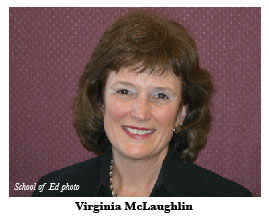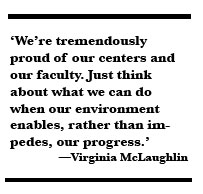BOV: School of Ed to get new facility
 William and Mary will move forward with plans
to build a state-of-the-art facility for the school of education at the
site of the former Williamsburg Sentara Hospital, President Gene R.
Nichol told members of the Board of Visitors during a meeting held Nov.
16-17.
William and Mary will move forward with plans
to build a state-of-the-art facility for the school of education at the
site of the former Williamsburg Sentara Hospital, President Gene R.
Nichol told members of the Board of Visitors during a meeting held Nov.
16-17.
After reviewing separate independent studies, in addition to the recommendations of several architectural firms, Nichol said the decision became obvious. The cost to build a new state-of-the-art facility was essentially the same as the cost to renovate the existing structure. A new structure would be significantly more cost-efficient in terms of long-term maintenance, and it would be designed specifically for the school of education.
“Our goal is to provide the best possible facility for a world-class school of education,” Nichol told board members. “To best serve the school’s outreach needs, to best serve the school’s mission and to develop a 21st-century school of education building, I am confident that can best be achieved through a new facility.”
 There
has been much discussion about whether the College should renovate the
old hospital structure off Monticello Avenue or build a new facility
designed specifically for a school that needs more space and a better
facility. Virginia McLaughlin, dean of the school of education,
explained to board members why a new facility would best meet the
growing needs and outreach services provided by the school’s students,
faculty and staff. A new facility would enable the school to expand its
outreach in the region and Williamsburg community, McLaughlin said. For
example, she said the popular Saturday and summer enrichment programs,
which are operated by the school’s Center for Gifted Education, would
have needed classroom space. The new facility would include a
state-of-the-art professional development center for practicing
educators as well as expanded space for the New Horizons Family
Counseling Center, which serves at-risk children and their families in
the Williamsburg area.
There
has been much discussion about whether the College should renovate the
old hospital structure off Monticello Avenue or build a new facility
designed specifically for a school that needs more space and a better
facility. Virginia McLaughlin, dean of the school of education,
explained to board members why a new facility would best meet the
growing needs and outreach services provided by the school’s students,
faculty and staff. A new facility would enable the school to expand its
outreach in the region and Williamsburg community, McLaughlin said. For
example, she said the popular Saturday and summer enrichment programs,
which are operated by the school’s Center for Gifted Education, would
have needed classroom space. The new facility would include a
state-of-the-art professional development center for practicing
educators as well as expanded space for the New Horizons Family
Counseling Center, which serves at-risk children and their families in
the Williamsburg area.
“We’re tremendously proud of our centers and our faculty,” said McLaughlin, adding that the school’s faculty are among the College’s top producers each year in terms of research grants, which total between $5 million and $8 million annually. “Just think about what we can do when our environment enables, rather than impedes, our progress,” she said.
Three years ago, McLaughlin said, officials knew they needed more space. Currently more than half of the school’s classes are taught outside of its cramped quarters in Jones Hall. Many of the school’s programs and centers are spread out in satellite buildings both on and off campus because there simply is not enough space in Jones Hall.
A study by Clark Nexsen confirmed the extent of the school’s needs, McLaughlin said. According to the report, the school should have a facility of more than 100,000 square feet to meet its current needs. Existing space at Jones Hall totals a little more than 25,000 square feet.
“We were not simply feeling a little cramped—only about 25 percent of our space needs are met,” McLaughlin said. “Right now we’re maxed out. We truly have no place to put people.”
As part of its due-diligence process in acquiring the hospital property, William and Mary commissioned two independent studies to examine the best options for relocating the school of education to the site. Clark Nexsen determined that the cost for renovation and the cost for new construction were essentially the same—both were in the mid-$40 million range. Earlier this year, the College asked another firm, the Smith Group, to verify those findings, which they did. Since then, five architectural firms bidding for the project reached the same conclusion, officials said.
“It’s well known within the board that I was skeptical about the possibility of new construction,” Nichol said. “I have slowly and reluctantly, but now strongly, become convinced by the facts that we ought to construct a new facility.”
According to the studies, a building designed specifically for the school of education would require approximately 109,000 square feet. However, fitting the school into the existing structure would require 129,000 square feet but leave several areas of unusable space since the current building encompasses 217,000 square feet. Those areas would still need to be heated and cooled and would add to the cost of maintaining the building. The studies also determined that new construction would take 33 months, while renovating the existing building would take 39 months to complete.
Anna Martin, vice president for administration, said the College has hired Sasaki Associates, Inc., to design the new facility. That firm designed the two Jamestown residence halls that opened this fall, as well as a 2002 master plan for the campus.
Board members agreed that new construction made the most sense. “I think this is a no-brainer,” said board member Sarah Gore (’56). “This is a fabulous opportunity and we need to move on it.”














